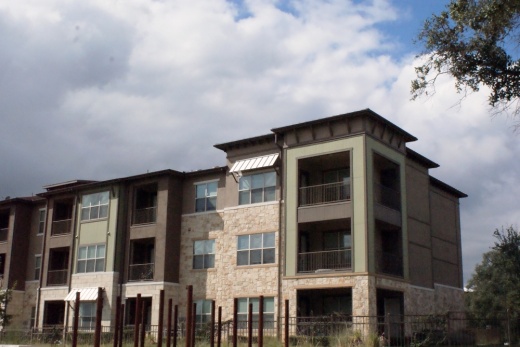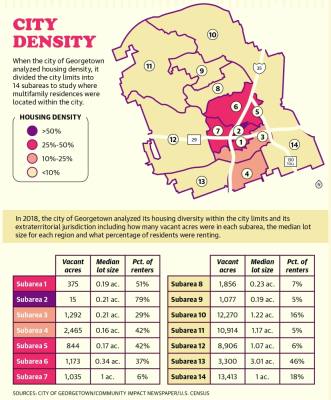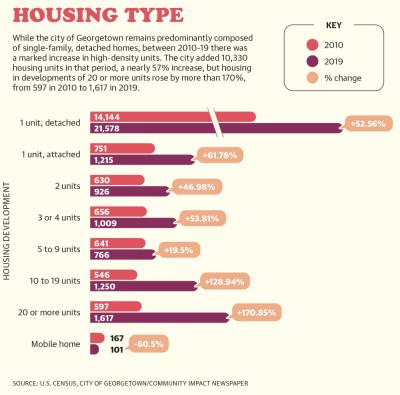Since 2010, the city of Georgetown’s population has increased by nearly 20,000 people, rising from 47,400 to 67,176 between 2010 and 2020, according to U.S. census data.
“What we have seen in the last three to five years is growth is occurring so much faster than any demographer, any economist, could have predicted, and we have got to get [infrastructure] on the ground now,” Georgetown Mayor Josh Schroeder said about the growing population of Georgetown. “Even 18 months ago, the growth numbers were off the charts, and now, those growth numbers are minuscule compared to what we’re seeing.”
In 2020, City Council formally adopted the comprehensive plan called the 2030 Plan, as a guide for future development to alleviate growth expected by 2030.
Georgetown Assistant City Planner Nathaniel Waggoner said it is a visionary plan for how the city will grow and what the city will look like in the future, especially for multifamily and mixed-use housing. The city charter lays out the 13 components of the comprehensive plan, one of those components being the land-use plan that directs where it is appropriate to place multifamily housing.
While adopted in 2020, the 2030 plan was updated in 2018 after the community asked the city to address housing diversity and affordability in Georgetown.
“One of the changes that came as a result of this land-use plan update was trying to locate high-density residential [areas], which is what we refer to as multifamily,” Waggoner said.
The city locates medium- and high-density residential areas close to amenities such as parks, retail, street networks and utility systems that can support multifamily housing. This is important when planning for the kind of growth Georgetown is to expect in the next nine years, Waggoner said.
According to the comprehensive plan, the population of Georgetown is estimated to reach over 100,000 by 2030, and because of this, the city is making land-use decisions that promote the development and redevelopment of target areas.
Schroeder said the city’s first priority is getting the infrastructure in place to support the new housing Georgetown will need, like installing pipes for water, wastewater and building roads.
“Growth is coming, so the only question is, do we control and manage that growth in such a way that doesn’t change the character and culture of our community?” Schroeder said. “To do that, infrastructure is the key because the pressure points, the pain points of growth are traffic and not being able to water your lawn in August.”
City Council Member Tommy Gonzalez said he believes Georgetown is not going to have any issues building needed housing by 2030.
“I believe right now there [are] over 25,000 residential plats, and about 15,000 of them are actively being worked [on] as of today,” Gonzalez said. “Multifamily is just a part of the total mix, and at some point, the city may decide what mix [or] ratio [of] single-family versus multifamily is going to be right for Georgetown; I don’t think we’ve had that discussion yet.”
Gonzalez said locating a lot of multifamily housing in one area can cause challenges, such as not having enough amenities for the population in that area. However, Gonzalez pointed out the same challenges arise regardless of single-family or multifamily homes when it comes to overcrowding infrastructure, and that is why a balance is so important, and that is what the city is working toward.
“The southeast area has been the fastest-growing area in probably the last couple of years,” Gonzalez said. “That’s where a lot of the focus has been; that’s where there’s been more scrutiny as to where [a] new development comes in and where it’s going to be placed.”
Gonzalez said Georgetown City Council has approved many units for multifamily housing and will continue to approve them around the city. Currently, there are approximately 6,000 units already approved and, recently, at the new Wolf Ranch Estates development, there are 700 units already on the ground with another 1,500 that also received approval.
“I mean, that’s a lot of [units],” Gonzalez said. “It’s kind of like our development department can close down shop and, just what’s on the books now, they can be busy for the next five to seven years.”
Waggoner also said that community feedback on the 2030 Plan wanted City Council to address future growth as well as diversity of housing and affordability.
According to the rent estimate database from Apartment List, rental prices are now 21% higher than in 2020, the average rental price being $1,524 spanning all units.
Research from Rob Warnock and Lilla Szini of Apartment List found that a slowdown in the housing market due to the pandemic has created greater competition in the current market because of a resurgence in home buying. This makes renting seem more affordable because of skyrocketing home prices and more attainable because more homebuyers are crowding the market, according to their data.
The number of home sales decreased 2.7% in Williamson County in September, compared to 2020, but sales dollar volume increased by 33.2%, and the median price for a home increased 37.5% to $435,000, according to the Austin Board of Realtors.
Gonzalez said he does not think multifamily homes will help residents decide between renting and buying. He points out that, in the current market, it might be just as expensive to rent, rather than buy.
“Just keep in mind, just because it’s multifamily, doesn’t mean it’s inexpensive,” Gonzalez said. “I think the going rate for a two-bedroom, two-bath apartment in Georgetown might be $1,500 or $1,600, so it’s multifamily, but it’s no cheaper than buying a home.”
Gonzalez said the problem is in the market, not the city, when it comes to property values, and the biggest challenge the city has is staying ahead of the growth, making sure those housing units are where they need to be and making the best use of the land for a growing population.
“Whatever we build will be there for the next 50 years,” Gonzalez said. “We all face the same issues on how fast we can get stuff on the ground and having the right mix for [the] community.”







